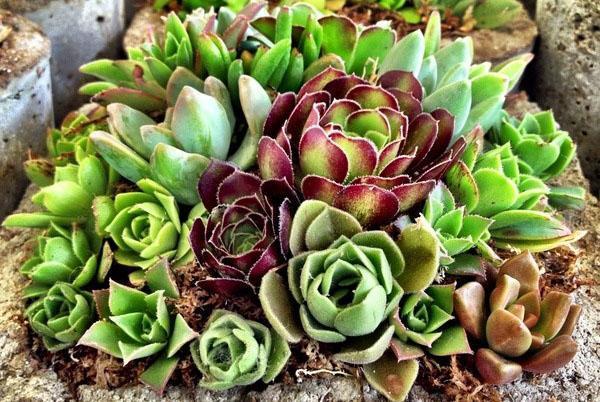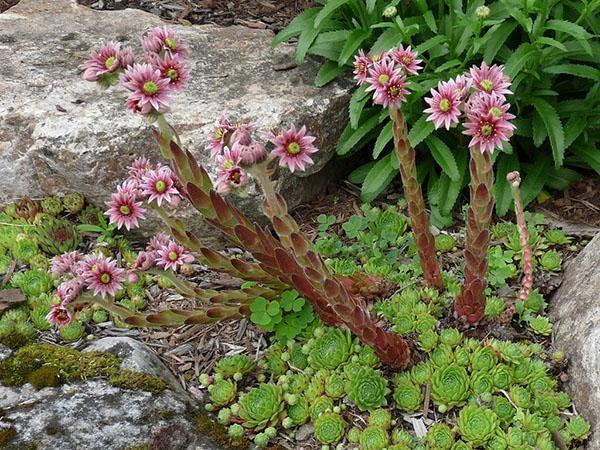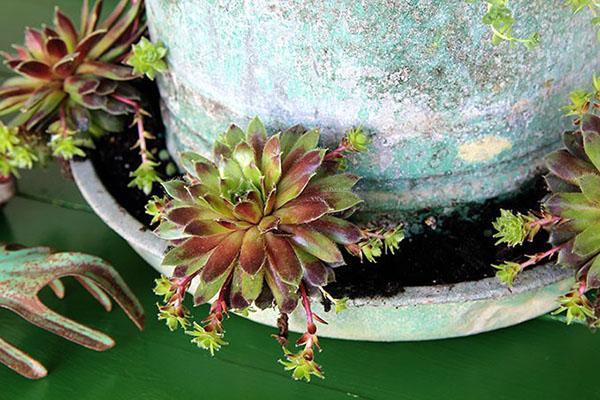To create a rock garden, we grow young in the open field
 Rejuvenated, capable of rooting among stones, content with drops of water and multiplying in the most difficult conditions, is rightfully recognized as the most unpretentious plant. If a young man was chosen to decorate the rock garden, borders or other corners of the garden, planting and caring for the plant in the open field will not require serious efforts from the owner of the site.
Rejuvenated, capable of rooting among stones, content with drops of water and multiplying in the most difficult conditions, is rightfully recognized as the most unpretentious plant. If a young man was chosen to decorate the rock garden, borders or other corners of the garden, planting and caring for the plant in the open field will not require serious efforts from the owner of the site.
Numerous species of juveniles belonging to the Tolstyankov family are found not only in flower beds and alpine slides. These succulents are quite appropriate in the forest and forest-steppe zone of Europe and Asia. Herbaceous winter-hardy perennials are extremely undemanding to growing conditions, reproduce by seeds, but more often form a dense resemblance of a carpet, occupying the territory with the help of daughter plants.

How and when to plant young in open ground? What do you need to know about plant care?
Features and methods of reproduction rejuvenated
 Today the youth is becoming more and more popular. More than a dozen species of this plant are used as a green garden decoration, and the number of varieties bred has long exceeded several hundred. Gardening centers and nurseries for planting and caring for juveniles in the open field offer summer residents young rooted rosettes and seeds.
Today the youth is becoming more and more popular. More than a dozen species of this plant are used as a green garden decoration, and the number of varieties bred has long exceeded several hundred. Gardening centers and nurseries for planting and caring for juveniles in the open field offer summer residents young rooted rosettes and seeds.
Using daughter plants is much easier. They easily take root in a new place and soon they themselves give rise to tiny offspring sitting on elongated mustache shoots.
The amusing appearance of a large rosette strewn with children predetermined another name for the young, under which the plant is known in the USA and Europe. This is a hen with chickens.
It is more difficult to grow young with seeds. But for those gardeners who want to replenish their collection with a multitude of unpretentious plants dissimilar to each other, it is worth trying to master the cultivation of young for open ground from seeds.
Growing young from seeds in the open field
 In order to plant the young in the ground in the middle of summer, sowing is carried out in February or in early March. The seedlings do not need a large layer of soil, so choose a wide, but not deep container with drainage holes.
In order to plant the young in the ground in the middle of summer, sowing is carried out in February or in early March. The seedlings do not need a large layer of soil, so choose a wide, but not deep container with drainage holes.
For planting rejuvenated, you need a light, aerated substrate that excludes stagnant moisture. Succulents do not need a lot of nutrients, so a ready-made composition for cacti or a mixture of equal parts of peat and sand with the addition of crushed charcoal is quite suitable for seedlings.
The seeds are spread over a damp surface and barely sprinkled with fresh soil. Germination takes place under a film or glass. Until the shoots appear, the greenhouse is ventilated from time to time, preventing condensation from forming. With the appearance of sprouts, the container is transferred to the sun, moderately but regularly watered.
For seedlings to be strong, they need a lot of light. But direct sunlight, especially at noon, can burn young, fragile leaf plates.
After about two months, the plants dive, spreading 5–6 cm apart.Almost all varieties intended for planting in open ground are rejuvenated by July, ready for planting for permanent residence.
Planting rejuvenated in open ground and caring for seedlings
 Before planting rosettes grown or harvested from adult plants, you need to select a suitable site. In the sun, rejuvenation forms denser decorative rosettes than in the shade. In addition, small plants are easily lost among the taller population of the flower bed. Therefore, for planting rejuvenated and caring for him in the open ground, places on curbs, the foreground of a rock garden or flower beds are more suitable. The culture perfectly lives on balcony boxes, flowerpots.
Before planting rosettes grown or harvested from adult plants, you need to select a suitable site. In the sun, rejuvenation forms denser decorative rosettes than in the shade. In addition, small plants are easily lost among the taller population of the flower bed. Therefore, for planting rejuvenated and caring for him in the open ground, places on curbs, the foreground of a rock garden or flower beds are more suitable. The culture perfectly lives on balcony boxes, flowerpots.
It was rejuvenated unpretentious, but it grows better in open sunny places with light soil. Her fertility plays a minor role.
Rosettes grow well even on rocky hills with a small alluvial layer of soil and almost no humus sand. Sand is added to dense clay soil or black soil; a useful component of the substrate will be crushed charcoal, fine expanded clay or pebbles. They are also used to mulch the soil surface after planting.
Subsidiary rosettes appear on the young in June, then they grow quickly and after a couple of weeks are ready to be transferred to a new permanent place. In a number of regions of the Urals, in the north-west and in Siberia, planting was young in open ground and the care of new plants in a flower bed can be postponed for 7-10 days, but this does not affect the survival rate of an unpretentious ornamental culture.
Before planting young rosettes, it is very important to rid the soil of weeds, especially perennial vegetation propagating by rhizomes. When the young ones begin to grow, the appearance of weeds will worsen the appearance of the flower bed, but it will be very difficult to get rid of them without harming the cultivated species.
The distance between individual rosettes during planting depends on the varietal characteristics and growth rate. The larger the adult specimens, the less often the planting of young plants rejuvenated. On average, the interval between holes is 5–10 cm. But next year, in place of single outlets, there will be a luxurious carpet with a rich texture and palette.
Care for juveniles in the open field
 The rejuvenated plant is planted in moist soil, then the site is carefully watered using a divider. In the future, most of the cultivated species do without additional care. Only in especially hot months does the young discolor and lose its tone, letting it know about a moisture deficit.
The rejuvenated plant is planted in moist soil, then the site is carefully watered using a divider. In the future, most of the cultivated species do without additional care. Only in especially hot months does the young discolor and lose its tone, letting it know about a moisture deficit.
The plant is excellent for shallow sprinkling, which does not erode the soil and does not violate the integrity of the green cover.
Until the rosettes grow, it is important to keep the soil loose and clean. Top dressing for the young is optional. If they are carried out, then only with liquid agents in the spring and during the period of active education of children.
With minimal care after planting in open ground, the young by the fall had already fully rooted and grown. Therefore, such plants overwinter well. But if they ate too late with disembarkation, not acclimatized sockets are affected by frost and do not survive until winter.
 You can save the outlets planted in August and September by covering them with spruce branches or covering material for the winter. In the spring, in the field of melting snow, such protection must be removed immediately so that the plants do not rot.
You can save the outlets planted in August and September by covering them with spruce branches or covering material for the winter. In the spring, in the field of melting snow, such protection must be removed immediately so that the plants do not rot.
Before wintering, mature plants are cleaned of wilted peduncles, dead leaves and other plant debris. Since the plants retire with green leaves, caring for juveniles outdoors in winter involves maintaining a sufficient layer of snow over the flower bed. Young people do not need more attention. As soon as the spring warmth comes, and the snowdrifts melt, the tight green rosettes will appear rejuvenated.